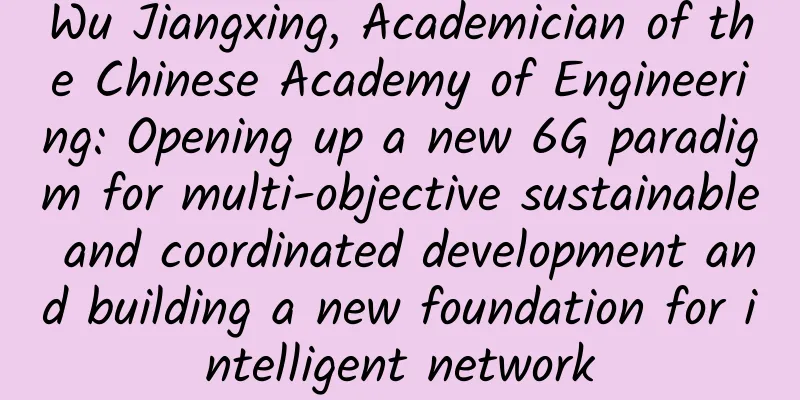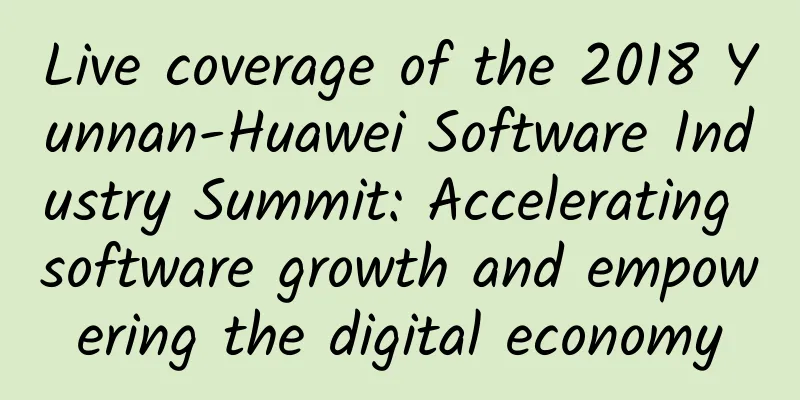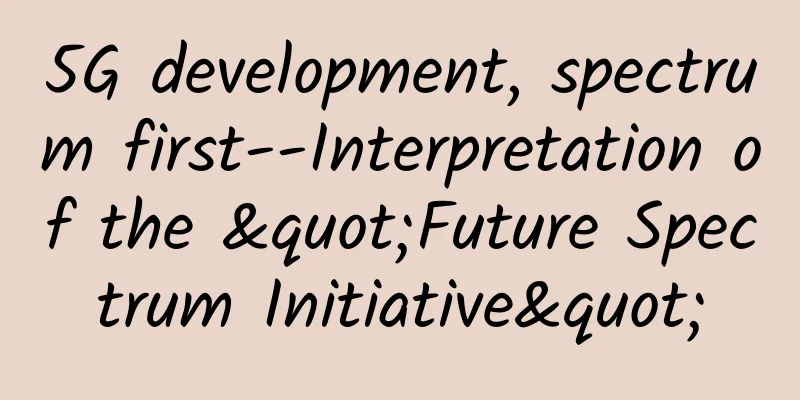Wu Jiangxing, Academician of the Chinese Academy of Engineering: Opening up a new 6G paradigm for multi-objective sustainable and coordinated development and building a new foundation for intelligent network

|
As 5G network construction accelerates, related applications are beginning to flourish and penetrate into thousands of industries. According to the development rhythm of the mobile communications industry of "using one generation, building one generation, and developing one generation", the industry generally predicts that 6G will be commercially available around 2030. As an industry event in the 6G field, the second "Global 6G Technology Conference" will be held online from March 22 to March 24, 2022. On the eve of the conference, Wu Jiangxing, an academician of the Chinese Academy of Engineering, said in an exclusive interview with C114 that 6G, as a supporting technology for intelligent network infrastructure after 2030, needs to change the basic development model in the field of mobile communications, open up a new paradigm that supports multi-objective sustainable collaborative development, provide a new multi-modal network environment where evolution and change can coexist, and create a new foundation for intelligent network with generalized functional safety characteristics. In addition, Wu Jiangxing suggested that my country's 6G research should continue to maintain its advantages in technologies such as intrinsic security and multimodal networks to lay a good foundation for standard setting; at the same time, it should dare to propose new theories, open up new fields, explore new paths, and work hard on originality and uniqueness to accumulate strength for my country to lead the development of 6G. 6G Vision: Opening up a new paradigm to support multi-objective sustainable collaborative developmentAs the saying goes, 4G changes life, and 5G changes society. So what kind of changes will 6G bring? According to the currently known information, the speed of 6G can reach about 50 times that of 5G. Therefore, it can have richer and more diverse application scenario requirements and challenges, wider coverage, and even realize air-to-ground connection. Higher speed can realize cross-border integration and intelligent connection of scenarios. It is not difficult to judge that 6G technology will change the world! However, if 6G technology wants to better enable the smart world in the future, it must have a clear development vision. Academician Wu Jiangxing said that as an important supporting technology for intelligent network infrastructure after 2030, 6G can no longer continue the traditional path of pursuing leaps in single technical indicators such as coverage, bandwidth, and latency. It must explore and open up a new paradigm of sustainable and coordinated development of multiple goals such as technical performance, cost investment, energy consumption, safety and reliability, and continuous efficiency. "In fact, whether it is China, the United States, Europe or Japan, in their released 6G visions, they all emphasize the simultaneous improvement and optimization of multiple goals such as communications, security, energy consumption, services, and efficiency," Wu Jiangxing pointed out. Specifically, the National Science Foundation of the United States launched the RINGS project plan for the NextG network system, emphasizing the development of network resilience, including security, adaptability, autonomy and reliability; the North American 6G Alliance proposed the first 6G vision for North America, which also includes trust, security and resilience, as well as cost-effectiveness and sustainability; the main research challenges identified by the EU 6G flagship project Hexa-X include intelligent connectivity, multi-network aggregation, sustainability, and network operation resilience and security; the B5G development strategy released by the Japanese Ministry of Communications proposed that the 2030 social vision is reliable, inclusive and sustainable, and B5G/6G needs to achieve ultra-low power consumption, autonomy, scalability, ultra-security and resilience. The series of white papers such as "6G Network Architecture Vision and Key Technology Outlook" and "6G Network Security Vision Technology Research Report" released by my country's IMT-2030 (6G) Promotion Group in 2021 also summarize the overall vision of endogenous intelligence, security, resilience and autonomy, green energy saving, and sustainable development. Academician Wu Jiangxing believes that 6G will integrate theories and technologies from multiple fields and aspects such as IT, CT, OT, DT, ST and AI, systematically consider the relationship between the underlying intelligent network and the upper-level intelligent application services, and scientifically integrate the use of distributed diversified resources such as computing, storage, network, access and transmission. It will transform the traditional development paradigm of relying on the "naked" access technology of a few iconic technologies, the "decoupling" of networks and services, and the "patch" security measures based on prior knowledge, and provide theoretical and technical support for building a flexible, trustworthy/scalable 6G infrastructure with inherent security functional characteristics. 6G network: Building a new multi-modal network environment where evolution and change can coexistThe industry predicts that in the future, 6G services will show new development trends such as immersion, intelligence, and globalization, and will further form business applications such as immersive cloud XR, holographic communication, sensory interconnection, inclusive intelligence, and communication perception, bringing more colorful social life scenes. "The diversified services of 6G networks require diversified network technology support." Academician Wu emphasized that 6G networks must establish a development paradigm that separates the network technology system from the supporting environment, and establish a multimodal network environment. In this way, the adaptability of 6G infrastructure to different application scenarios can be fundamentally improved through multimodal network modes within the same technical physical environment, meeting the needs of various vertical industries for high-performance, high-efficiency, high-security, high-availability, personalized, and customizable applications, whether it is "separation of network and business", "strong correlation between business and network", or "diversified networks and services themselves are their inherent application scenarios", "the need to provide customizable services without losing common services" or "simply rejecting unified network facilities and services", fundamentally meeting the business needs of network intelligence, diversification, high security, high robustness, and high efficiency. "Separation of network technology system and supporting environment" is the basic thinking perspective of the fourth network development paradigm proposed by Academician Wu. Its methodology is called Polymorphic Network Environment (PINE), also known as "Network of Networks". Its practice norms are "The network physical layer environment must have attributes such as reconfigurability, customization, diversification, inherent security, and resource sharing, and is weakly related to the specific network technology system on top of it. As a "network of networks" that supports the coexistence, evolution and transformation of diversified or diverse network systems, and can integrate and develop, it can not only ensure the self-sustaining development of various network systems and related services, but also realize the intelligent, efficient, and secure integrated deployment and management of diversified network systems. Its capability coordinate system is reflected in three aspects: First, the fully definable network baseline capability is the basis for achieving the “separation of supporting environment and technical system”; Second, an endogenous security structure based on dynamic heterogeneous redundancy is embedded in PINE to transform “unknown unknowns” security threats into “known unknowns” reliability events; Third, the multimodal network environment supports various network usage needs to be dynamically added/unloaded or run in the form of network modes on a unified physical network element facility, and is processed according to the modal customized software and hardware configuration, business characteristics, operation and maintenance specifications and security policies, thereby achieving the coexistence, independent evolution and transformation of multiple network modes in the same technical physical environment, secure isolation between modes and inherent security protection functions. 6G security: Building a new foundation for intelligent networks with broad functional safety featuresWithout network security, there is no national security. Indeed. In the future, 6G will not only bring users a more immersive and ultimate experience, meet the communication and interconnection needs of human multi-sensory, emotional and conscious levels, but also be widely used in entertainment life, medical health, industrial production and other fields, to help my country's digital transformation and upgrading of various industries, and meet the various application needs of the future intelligent society. In the 6G era, people are facing not only a simple Internet of Things society, but a colorful intelligent world. Whoever can grasp the security capabilities in this era can avoid being hit by dimensionality reduction. So, how will the 6G network security system be built? Academician Wu Jiangxing believes that in the initial discussions of 6G vision, requirements and key technologies in various countries around the world, security, resilience and sustainability have received extraordinary attention. Facing the world of human-machine-object fusion, 6G needs to make new expansions in the connotation and extension of mobile communication network security. In addition to focusing on traditional information security confidentiality, integrity, availability and privacy protection, it is also necessary to pay special attention to the generalized functional safety (Safety & Security) of 6G networks, so as to effectively respond to the "paralyzing and chaotic" attacks on digital infrastructure by "high-intensity cyber warfare". The essence of generalized functional safety is the expansion and extension of the traditional functional safety (reliability) concept under the conditions of cyber attacks. If the target system has both traditional reliability disturbance effects, such as functional safety issues such as random failures and system failures, and cyber attack disturbance effects based on software and hardware vulnerabilities and backdoors in the target system, it is called a generalized functional safety problem. Correspondingly, if there is a robust or flexible construction model that can not only keep the given model function within the set reliability range under the disturbance of random factors, but also ensure that the security of the model function is within the threshold of quantifiable design and verification metrics under the influence of cyber attacks such as software and hardware vulnerabilities and backdoors in the model, then the model is said to have structurally determined generalized functional safety. Academician Wu Jiangxing introduced that my country pioneered the theory of endogenous security and mimicry defense methods in cyberspace in 2013, and invented the dynamic heterogeneous redundant architecture DHR with generalized robust control mechanism, which is the only endogenous security architecture in the world that does not rely on (but does not exclude) prior knowledge and additional defense methods. Practice has proved that it can have a subversive impact on the theory and methods of network attacks based on software and hardware design defects, and is hailed as a revolutionary technology that "changes the rules of the game". In particular, the wireless intrinsic security theory and method proposed by my country in recent years based on reconfigurable intelligent surface (RIS) can unify anti-interference, communication and security under an integrated architecture. By utilizing the refined perception and real-time reconstruction of wireless channels provided by RIS, the wireless environment can be artificially shaped to actively customize and transform the wireless intrinsic security attributes, further enriching, amplifying and accelerating the randomness, heterogeneity and dynamics of the electromagnetic environment. At the signal layer (physical layer), wireless communication generalized robust control against wireless generalized uncertain disturbances can be realized, functional safety and information security integrated design can be achieved, and the practice specifications of the new paradigm of 6G wireless intrinsic security can be formed. Broadly speaking, functional safety is an enabling technology for cyberspace-related technologies. It has broad compatibility and openness. Horizontally, it can be integrated with traditional external security protection technologies or systems to form a coordinated defense. Vertically, it can be integrated with other security protection technologies or systems on the intelligent connected basic platform to form a deep defense. 6G research: based on its own advantages, continue to open up and cooperateAt present, the global 6G development is still in its early stages. We should keep an open mind and accommodate beneficial views from all parties in 6G research and technology. Wen Ku, Vice Chairman and Secretary General of the China Communications Standards Association, publicly emphasized that we should plant more trees in the pre-research of 6G technology and not rush to cut down trees. It is not appropriate to make a conclusion on the 6G technology route too early to avoid affecting the innovative development of 6G. In fact, since 2017, the team of Academician Wu Jiangxing has made some trend-setting explorations in the research of new development paradigms. China Science Press and German Springer Publishing House have successively published four sets of theoretical monographs: "Introduction to Cyberspace Mimic Defense", "Principles of Cyberspace Mimic Defense-Generalized Robust Control & Endogenous Security", "Cyberspace Mimic Defense-Generalized Robust Control and Endogenous Security", and "Cyberspace Endogenous Security-Generalized Robust Control & Mimic Defense". More than 300 international/domestic patents have been applied for, and 8 core patents have been authorized. Some views on the development paradigm of cyberspace endogenous security, the development paradigm of separation of network technology system and supporting environment, and 6G wireless endogenous security have been published in authoritative journals and academic conferences such as "Science China: Information Sciences", "China Communications", "Journal of Communications", "Journal of Electronics", and "Journal of Information Security". According to Academician Wu Jiangxing, funded by the key special project of cyberspace security under the National Key R&D Program, the development of cyberspace intrinsic security has formed a full-chain layout from hardware to software, from components to systems, from technology to applications around the field of network communications, laying a solid foundation for the innovative development of the discipline, and also forming a series of application technologies in the fields of supporting technology, common basic technology, network information infrastructure, industrial control and big data, chips, network service applications, etc. The recently developed "Multi-antenna Wireless Intrinsic Security IoT Base Station Principle Verification System" was selected to participate in the "Nanjing Innovation Week "Black Technology" Product/Technology Exhibition", and the developed "5G Wireless Intrinsic Security Base Station Principle Verification System", "5G Intrinsic Security Core Network System", and "5G Signaling Protection System" will be released at the Cyberspace Intrinsic Security Alliance Development Conference. At the same time, funded by the National Key R&D Program's broadband communications and new network key special projects, we have innovatively developed a multimodal network with a separation of technical systems and supporting environments, developed multimodal network element equipment, multimodal addressing and routing systems, and developed the industry's first multimodal smart network principle platform, achieving the coexistence of five different modes in the same network infrastructure. It is expected that by the end of 2022, a cross-regional real multimodal test network will be built in the Guangdong-Hong Kong-Macao Greater Bay Area, covering three cities, covering no less than 35 real network nodes, supporting no less than six network modes, and conducting no less than eight network tests and application demonstrations. At the end of the interview, Academician Wu Jiangxing suggested that my country's 6G research should continue to maintain its advantages in technologies such as intrinsic security and multimodal networks, accelerate the implementation of new technologies, and the academic and industrial circles should adopt an open and inclusive attitude to increase cooperation with international standard organizations and platforms in the field of mobile information such as ITU and 3GPP to lay a good foundation for standard setting. At the same time, they should dare to put forward new theories, open up new fields, explore new paths, and work hard on originality and uniqueness to accumulate strength for my country to lead the development of 6G. |
<<: I’ve explained the QUIC protocol in ten minutes. Do you understand it?
>>: PTC DPM: Dramatically improving manufacturing efficiency again
Recommend
4 Steps to Prepare Before Deploying SD-WAN
Software Defined Wide Area Networks (SD-WAN) are ...
RAKsmart: US/Hong Kong/Japan VPS starting from $1.99 per month, G-port unlimited traffic server starting from $199 per month
RAKsmart is an early-established foreign hosting ...
Comparison of 5G tariffs in China and South Korea: Which country’s users are the happiest?
Globally, South Korea was the first country to co...
Survey shows consumers are very dissatisfied with 5G and cellular network quality
According to reports, Waveform released a survey ...
From 4G to 5G, is there only a 1G gap? Four major issues that need to be solved for 5G commercial use
Recently, the State Council issued the "Guid...
The road ahead is long and arduous. When will 5G packages become available to ordinary people?
"I won't buy any non-5G mobile phones&qu...
The eternal challenge of time series databases - solutions to the timeline expansion problem
Preface As the development of mobile terminals mo...
MWC19 Shanghai | Ruijie Networks invites you to gather together to see the cutting-edge and talk about the future
[[268236]] June 26-28 Asia's technology indus...
Synchronized is the king's harem manager, and thread is the queen
If synchronized is the "chief steward" ...
Can you understand Wdm in one minute?
Hello everyone, I am Xiaozaojun. [[329660]] When ...
LAN vs. WLAN: Connecting the Wired and Wireless Worlds
Local Area Networks (LANs) and Wireless Local Are...
PacificRack has run away
The tribe has not shared any information about Pa...
In the win-win multi-cloud era, Juniper Networks helps enterprises achieve digital transformation
In July this year, Gartner released the 2019 Data...
Let’s talk about Sentinel Quick Start
[[397765]] This article is reprinted from the WeC...
The 5G concept is very popular, but why is there no progress in the construction of public WiFi?
Since 2015, the country has begun to continuously...









